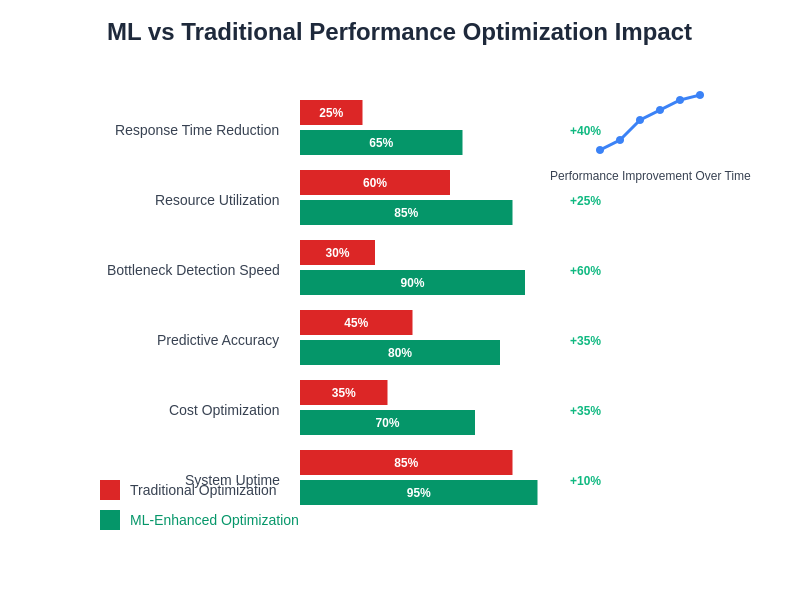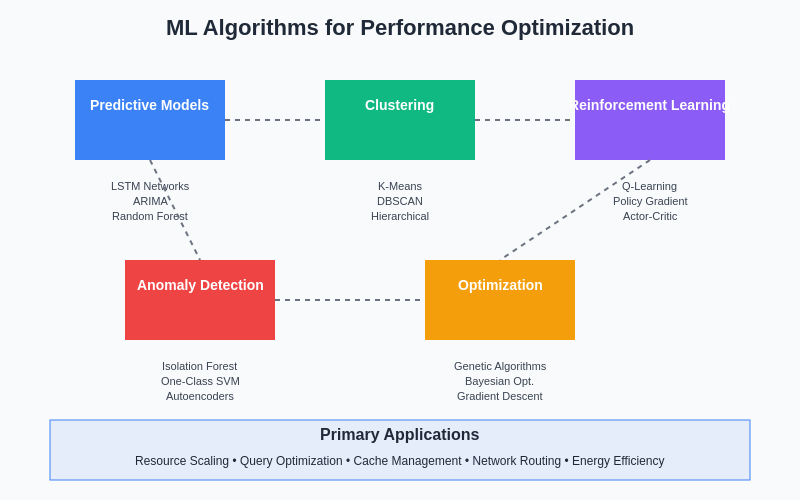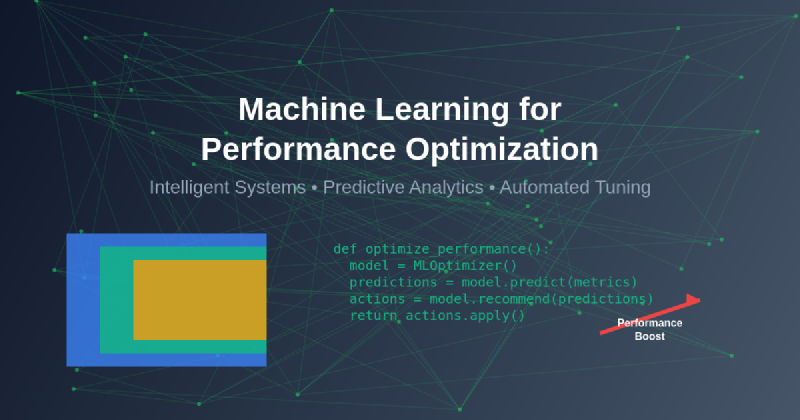The intersection of machine learning and performance optimization represents one of the most transformative developments in modern software engineering, fundamentally changing how systems monitor, analyze, and enhance their operational efficiency. Traditional performance optimization approaches relied heavily on manual analysis, static rules, and reactive measures that often fell short of addressing the complex, dynamic nature of contemporary software systems. Machine learning has emerged as a powerful paradigm that enables predictive optimization, intelligent resource allocation, and automated performance tuning that adapts to changing conditions in real-time.
Explore the latest AI developments to understand how machine learning continues to reshape performance optimization across diverse technological domains. The integration of machine learning into performance optimization workflows has created unprecedented opportunities for creating self-optimizing systems that continuously learn from operational data and proactively address performance bottlenecks before they impact user experience or system reliability.
The Evolution of Performance Optimization
Performance optimization has undergone a remarkable transformation from manual profiling and static optimization techniques to sophisticated machine learning-driven approaches that can predict, prevent, and resolve performance issues autonomously. Traditional methods relied on developers manually identifying bottlenecks through profiling tools, analyzing performance metrics, and implementing fixes based on intuition and experience. While these approaches provided valuable insights, they were limited by human capacity to process vast amounts of performance data and identify complex patterns that span multiple system components and time periods.
Machine learning has revolutionized this landscape by enabling systems to automatically discover performance patterns, predict future bottlenecks, and implement optimization strategies without human intervention. This shift represents more than just technological advancement; it embodies a fundamental change in how we conceptualize system performance as a dynamic, learnable characteristic rather than a static property determined solely by code quality and system architecture.
The modern machine learning approach to performance optimization leverages historical performance data, real-time metrics, and environmental factors to create predictive models that can anticipate performance degradation, optimize resource allocation, and automatically tune system parameters for optimal efficiency. This proactive approach has proven significantly more effective than reactive optimization strategies, particularly in complex distributed systems where performance characteristics can change rapidly based on user load, data patterns, and external dependencies.

The comprehensive machine learning optimization process encompasses data collection, pattern analysis, predictive modeling, and automated implementation in a continuous feedback loop that enables systems to learn and adapt to changing performance requirements over time.
Predictive Performance Analytics
One of the most significant contributions of machine learning to performance optimization lies in its ability to predict performance issues before they manifest as user-visible problems. Predictive performance analytics utilizes historical performance data, system metrics, and usage patterns to forecast potential bottlenecks, resource constraints, and performance degradation scenarios. This capability enables development teams to implement preventive measures and optimize systems proactively rather than responding to performance incidents after they occur.
Machine learning models trained on comprehensive performance datasets can identify subtle patterns and correlations that human analysts might overlook, such as the relationship between specific user behavior patterns and database query performance, or the correlation between memory usage patterns and application responsiveness. These insights enable more sophisticated optimization strategies that address root causes rather than merely treating symptoms of performance problems.
Leverage advanced AI capabilities with Claude to enhance your performance optimization strategies through intelligent analysis and predictive modeling capabilities. The integration of machine learning into performance analytics has created new possibilities for understanding system behavior and implementing optimization strategies that adapt to changing conditions and requirements.
Intelligent Resource Management and Scaling
Resource management represents one of the most successful applications of machine learning in performance optimization, where algorithms learn from historical usage patterns to predict resource requirements and automatically scale infrastructure components accordingly. Traditional auto-scaling approaches relied on simple threshold-based rules that often resulted in over-provisioning or under-provisioning of resources, leading to either unnecessary costs or performance degradation during traffic spikes.
Machine learning-driven resource management systems analyze complex patterns in resource utilization, user behavior, and application performance to make more intelligent scaling decisions. These systems can predict traffic patterns, identify seasonal variations, and preemptively allocate resources based on anticipated demand rather than simply reacting to current metrics. This predictive approach significantly improves both cost efficiency and performance consistency by ensuring that adequate resources are available when needed while minimizing waste during low-demand periods.
Advanced machine learning models can also optimize resource allocation across different system components, considering the interdependencies between services and the impact of resource constraints on overall system performance. This holistic approach to resource management enables more efficient utilization of available infrastructure while maintaining optimal performance characteristics across all system components.
Automated Bottleneck Detection and Resolution
Machine learning has transformed bottleneck detection from a manual, time-intensive process into an automated capability that can identify and often resolve performance issues without human intervention. Traditional bottleneck identification required extensive analysis of performance metrics, log files, and system traces to pinpoint the root causes of performance problems. This process was not only time-consuming but also prone to human error and limited by the analyst’s experience and domain knowledge.
Machine learning algorithms can process vast amounts of performance data in real-time, identifying anomalous patterns that indicate potential bottlenecks across multiple system layers simultaneously. These systems can correlate performance metrics from different components, identify cascading effects of performance issues, and prioritize optimization efforts based on their potential impact on overall system performance.
Some advanced machine learning systems can automatically implement optimization strategies when specific bottleneck patterns are detected, such as adjusting database connection pool sizes, modifying caching strategies, or redistributing workloads across available resources. This automated response capability significantly reduces the time between bottleneck detection and resolution, minimizing the impact on user experience and system reliability.
Dynamic Query and Algorithm Optimization
Database query optimization and algorithm selection represent areas where machine learning has demonstrated exceptional value in improving system performance. Traditional query optimizers relied on static cost models and heuristics that often failed to account for dynamic data characteristics, changing access patterns, and evolving system conditions. Machine learning-based query optimizers can learn from query execution history, adapt to changing data distributions, and select optimal execution plans based on real-world performance data rather than theoretical cost estimates.
Machine learning systems can also dynamically select the most appropriate algorithms for specific tasks based on input characteristics, system load, and performance requirements. For example, a machine learning system might choose between different sorting algorithms based on the size and characteristics of the data being processed, or select the most efficient machine learning model for a prediction task based on accuracy requirements and available computational resources.
This dynamic optimization capability extends beyond individual queries or algorithms to encompass entire workflows and processing pipelines. Machine learning systems can optimize the sequence of operations, select appropriate parallelization strategies, and adjust processing parameters based on real-time performance feedback and changing system conditions.
Adaptive Caching Strategies
Caching represents a fundamental performance optimization technique that has been significantly enhanced through machine learning applications. Traditional caching strategies relied on simple algorithms like Least Recently Used (LRU) or First In First Out (FIFO) that failed to capture the complex access patterns and data relationships present in modern applications. Machine learning has enabled the development of intelligent caching systems that can predict which data will be accessed, optimize cache placement across multiple tiers, and dynamically adjust caching policies based on changing usage patterns.
Machine learning-driven caching systems analyze historical access patterns, user behavior, and application characteristics to make more informed decisions about what data to cache, where to cache it, and when to evict cached items. These systems can identify temporal patterns in data access, predict future requests based on current activity, and proactively cache data that is likely to be needed, significantly improving cache hit rates and reducing response times.
Advanced machine learning caching systems can also optimize cache distribution across multiple servers or geographic locations, considering factors such as network latency, server load, and data locality to minimize access times and improve overall system performance. This intelligent cache management has proven particularly valuable in distributed systems and content delivery networks where cache placement decisions can significantly impact user experience.
Enhance your research and optimization efforts with Perplexity to stay current with the latest developments in machine learning-driven performance optimization techniques. The continuous evolution of caching strategies through machine learning represents just one example of how AI is transforming traditional optimization approaches into more intelligent and adaptive systems.
Real-Time Performance Monitoring and Alerting
Machine learning has revolutionized performance monitoring by enabling systems that can distinguish between normal performance variations and genuine anomalies that require attention. Traditional monitoring systems relied on static thresholds and simple alerting rules that often generated false positives during normal traffic variations or failed to detect subtle performance degradations that developed gradually over time.
Machine learning-based monitoring systems learn the normal performance characteristics of applications and infrastructure components, establishing dynamic baselines that adapt to changing conditions and usage patterns. These systems can detect anomalies that deviate from learned patterns, even when the absolute values remain within traditionally acceptable ranges. This capability enables earlier detection of performance issues and reduces alert fatigue by minimizing false positives.
Advanced machine learning monitoring systems can also correlate performance metrics across different system components to identify the root causes of performance issues and predict the potential impact of detected anomalies. This comprehensive approach to performance monitoring enables more effective incident response and helps prevent minor performance issues from escalating into major system outages.
Network and Infrastructure Optimization
Network performance optimization has been significantly enhanced through machine learning applications that can analyze traffic patterns, predict congestion, and optimize routing decisions in real-time. Traditional network optimization relied on static routing rules and manual configuration that often failed to adapt to changing traffic conditions and network topology. Machine learning enables dynamic network optimization that can respond to changing conditions and optimize performance across complex network infrastructures.
Machine learning systems can analyze network traffic patterns to identify optimal routing paths, predict bandwidth requirements, and implement traffic shaping policies that maximize network efficiency while maintaining quality of service requirements. These systems can also detect network anomalies that might indicate security threats or infrastructure problems, enabling proactive maintenance and optimization efforts.
Infrastructure optimization through machine learning extends beyond networking to encompass server placement, load balancing, and resource allocation across data centers and cloud environments. Machine learning systems can optimize these decisions based on factors such as geographic proximity to users, infrastructure costs, energy efficiency, and disaster recovery requirements.
Application-Specific Performance Tuning
Machine learning enables highly specialized performance optimization tailored to specific application types and usage patterns. Different applications have unique performance characteristics and optimization opportunities that generic optimization approaches often fail to address effectively. Machine learning systems can learn the specific performance patterns of individual applications and implement customized optimization strategies that maximize performance for particular use cases.
For web applications, machine learning can optimize page load times by predicting which resources users are likely to request and preloading them accordingly. For data processing applications, machine learning can optimize batch processing schedules, select appropriate processing algorithms, and adjust resource allocation based on data characteristics and processing requirements. For real-time applications, machine learning can optimize network protocols, adjust quality settings based on available bandwidth, and implement predictive buffering strategies.
This application-specific optimization capability enables much more effective performance improvements compared to generic optimization approaches, as the machine learning systems can focus on the specific performance bottlenecks and optimization opportunities that are most relevant to each application type.

The quantitative impact of machine learning on performance optimization demonstrates substantial improvements across all key metrics, with particularly significant gains in bottleneck detection speed, predictive accuracy, and cost optimization compared to traditional approaches.
Energy Efficiency and Green Computing
Machine learning has emerged as a powerful tool for optimizing energy efficiency in computing systems, addressing the growing concern about the environmental impact of data centers and computational infrastructure. Traditional approaches to energy optimization relied on simple power management strategies that often compromised performance for energy savings or vice versa. Machine learning enables sophisticated energy optimization that can maintain performance requirements while minimizing energy consumption.
Machine learning systems can predict computational workloads and optimize processor frequencies, memory configurations, and cooling systems to minimize energy consumption while meeting performance objectives. These systems can also optimize job scheduling and resource allocation to maximize the utilization of energy-efficient hardware components and minimize the use of high-power resources when possible.
Advanced machine learning energy optimization systems can consider factors such as renewable energy availability, electricity pricing, and cooling requirements to make holistic optimization decisions that minimize both energy consumption and operational costs while maintaining required performance levels.
Continuous Learning and Adaptation
One of the most significant advantages of machine learning-based performance optimization is its ability to continuously learn and adapt to changing conditions. Traditional optimization approaches often became less effective over time as system characteristics, usage patterns, and requirements evolved. Machine learning systems can continuously update their models based on new performance data, adapting their optimization strategies to remain effective as conditions change.
This continuous learning capability enables machine learning systems to discover new optimization opportunities, adapt to changes in user behavior, and maintain optimal performance even as applications and infrastructure evolve. The systems can also learn from the effectiveness of previous optimization decisions, refining their strategies based on observed outcomes and improving their optimization capabilities over time.
Continuous adaptation also enables machine learning systems to respond to seasonal variations, long-term trends, and gradual changes in system characteristics that might not be apparent through traditional monitoring approaches. This long-term learning capability provides significant advantages in maintaining optimal performance over extended periods.
Integration Challenges and Best Practices
Implementing machine learning for performance optimization requires careful consideration of integration challenges, data quality requirements, and model validation approaches. Successful implementation depends on having access to comprehensive, high-quality performance data that accurately represents system behavior under various conditions. Organizations must establish robust data collection processes, ensure data quality and consistency, and implement appropriate data governance practices to support effective machine learning applications.
Model validation and testing represent critical aspects of machine learning-based performance optimization, as incorrect optimization decisions can significantly impact system performance and user experience. Organizations must implement comprehensive testing frameworks that validate machine learning models under various conditions and establish rollback mechanisms that can quickly revert optimization changes if they produce unexpected results.
Integration with existing performance monitoring and management tools requires careful planning to ensure that machine learning-based optimization complements rather than conflicts with existing processes and procedures. Organizations must also consider the computational overhead of machine learning systems and ensure that the performance benefits outweigh the costs of implementing and maintaining the optimization systems.

The diverse landscape of machine learning algorithms available for performance optimization includes predictive models, clustering techniques, reinforcement learning, anomaly detection, and optimization algorithms, each suited for specific aspects of performance enhancement and system tuning.
Future Directions and Emerging Trends
The future of machine learning in performance optimization promises even more sophisticated capabilities as artificial intelligence technologies continue to evolve. Emerging trends include the development of more interpretable machine learning models that can provide insights into why specific optimization decisions were made, enabling better understanding and validation of optimization strategies.
The integration of large language models and natural language processing capabilities is beginning to enable performance optimization systems that can generate human-readable explanations of performance issues and optimization recommendations. This capability will make machine learning-based optimization more accessible to developers and system administrators who may not have extensive machine learning expertise.
Edge computing and distributed machine learning are also creating new opportunities for performance optimization at the network edge, where machine learning models can be deployed closer to users to minimize latency and improve responsiveness. These distributed optimization systems can coordinate their efforts across multiple edge locations to optimize performance from a global perspective while maintaining low latency for individual users.
The continued advancement of machine learning technologies promises to unlock new levels of performance optimization that were previously unimaginable, creating systems that can automatically optimize themselves across multiple dimensions simultaneously while adapting to changing conditions and requirements in real-time.
Disclaimer
This article is for informational purposes only and does not constitute professional advice. The implementation of machine learning for performance optimization should be carefully planned and tested in appropriate environments before deployment to production systems. The effectiveness of machine learning-based optimization may vary depending on specific use cases, system characteristics, and implementation approaches. Organizations should conduct thorough evaluation and testing before implementing machine learning-based performance optimization solutions.
